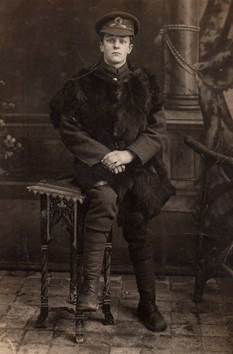
193937 &
WR/258995 Sapper
WILLIAM STEWART SPRINGHAM
Royal
Engineers
by
Lieutenant Colonel Edward De Santis, MSCE, P.E.,
MinstRE
(December 2022, revised March 2023)

Figure 1. Sapper William Stewart Springham,
R.E.
(Postcard photograph in the author’s collection)
NOTE: In Figure 1 Sapper Springham is wearing the protective coat of leather and goatskin that was issued to British soldiers in France and Flanders from early in 1918. The photograph was taken in France and on the reverse side, written in pencil are the words,
Springham R.E.
Fontinettes
INTRODUCTION
To begin this narrative of Springham’s life and military service it is necessary to mention that the family trees of the Springham family show his middle name as Stewart; however, his military service papers, many of which were signed by him, show his middle name as Stuart. His father’s middle name was Stewart, so there is good reason to believe that it may have been William’s middle name as well. Civil documents, where they were found, indicate that his middle name was indeed Stewart. All of his brothers’ middle names were Stewart. The preponderance of evidence indicates that his middle name was Stewart. His father was a native of Scotland and perhaps had an association with Clan Stewart. Why William chose to sign his name as Stuart in his military service documents is a mystery.
William’s family paid a high price for its service during the Great War of 1914-1918. While William survived the war, two of his brothers were not so fortunate. One who served in the Army was killed in action in France and the other, who served in the Royal Navy, died at home immediately after the war, in 1920, perhaps as a result of the Spanish influenza or some other serious ailment contracted while in service.
2. FAMILY INFORMATION AND EARLY LIFE
Family Information
William’s father was Alexander Stewart Springham (1869-1902) who was born in Barony, Lanark, Scotland. His mother was Minnie Margaret Springham, née Cox (1872-1937) of East Cowes on the Isle of Wight. Alexander Springham married Margaret Minnie Cox in the Register Office in Leeds, Yorkshire in December 1899. Their date of marriage and dates of birth of their children are the cause for some conjecture as will be noted below. The following is a list of their children as found in the Springham family trees on Ancestry.com:
· George Allen (aka Alan) Springham (1894-1959) was born in Aldershot, Hampshire and was baptized on 17 September 1905 at Bisley, Hampshire. Why there was a 10-year gap between his birth and baptism could not be determined.[1]
· William Stewart (aka Stuart) Springham (1896-1973) was born in Farnham, Surrey on 10 August 1896.[2] He was baptized in the Parish of Holy Trinity in Aldershot, Southampton on 4 November 1896. His baptism certificate shows the family living at 101 Artillery Terrace, High Street, Aldershot.
· Alexander Stewart Springham (1896-1916) was born in Aldershot.
· Henry Stewart Springham (1898-1920) was born in Plymouth, Devonshire.
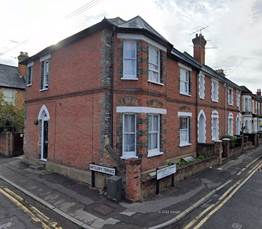
Figure
2. Artillery Terrace, Aldershot.
(Image courtesy of Google
Earth)
Since Alexander and Minnie were married in 1899 and all of their sons were born before 1899, one must consider two possibilities. Either all of the boys were Minnie’s sons by a previous marriage and they were adopted by Alexander Springham, or all of the boys were born out of wedlock and Alexander was their biological father. No resolution to this question was found during the course of this research.
Early Life
As indicated above, William Stewart Springham was born on 10 August 1896 in Farnham, Surrey, a town about four miles from the large military base at Aldershot. The 1901 Census of England shows the details of the Springham family as indicated in the table below.
1901 Census of England
Address: 3 Andover Terrace, Farnborough, Hampshire.(a) |
|||||
Name and Surname |
Relation |
Marital Status |
Age |
Profession or Occupation |
Birthplace |
Alexander S. Springham |
Boarder |
Married |
22 |
Soldier, Field Artillery(b) |
Scotland |
Minnie M. Springham |
Boarder |
Married |
29(c) |
|
Isle of Wight
|
George A. Springham |
Boarder |
Single |
7 |
|
Aldershot, |
Alexander S. Springham |
Boarder |
Single |
5 |
|
Aldershot, |
William S. Springham |
Boarder |
Single |
3 |
|
Aldershot, |
Henry S. Springham |
Boarder |
Single |
2 |
|
Portsmouth, |
TABLE NOTES:
(a) Farnborough is also only four miles from Aldershot. The Springhams were boarders in the residence at this address. This address no longer exists.
(b) Alexander S. Springham was a soldier in the Royal Field Artillery in 1901. This would explain why three of his sons were born at Aldershot, as Springham was probably serving there at the large military base, later to become known as “the home of the British Army.”
(c) Minnie was seven years older than her husband. It is quite possible that she had been married before and that the boys were her sons from a previous marriage. The fact that three of the boys were born at Aldershot may even indicate that her first husband also was a soldier.
(d) When Henry was born in Portsmouth it may have been due to his father being posted there while he was still in the Army.
Alexander Stewart Springham died in December 1902 at Hartley Wintney, Hampshire at the age of 35.[3] His death may have been the result of a terminal illness, or perhaps the result of an accident during training. Minnie must have been pregnant when he died as she had another son, James Springham (1903-1971) born in Farnborough.[4] If all of Minnie’s other sons had a father other than Alexander Stewart Springham, then James was their half-brother. The fact that Henry was born in Farnborough may indicate that Minnie moved back there after the death of her husband, perhaps to be near family or friends.
By 1911 Minnie Springham had moved to Watford, Hertfordshire with three of her sons as shown in the 1911 Census.
1911 Census of England and Wales
Address: 24 Southsea Avenue, Watford, Hertfordshire.[5] |
|||||
Name and Surname |
Relation |
Marital Status |
Age |
Profession or Occupation |
Birthplace |
Minnie Springham |
Head |
Widow |
39 |
Dressmaking |
Isle of Wight
|
William Springham |
Son |
|
14 |
School |
Aldershot, |
Henry Springham |
Son |
|
13 |
School |
Portsmouth, |
James Springham |
Son |
|
8 |
School |
Farnborough, |
There is evidence to indicate that young Alexander Stewart Springham was a Boy Soldier in 1911 serving in the Royal Horse Artillery at Seaforth Barracks in Lancashire;[6] hence, he is not in the 1911 Census with his mother and brothers. George Springham is also missing from the 1911 Census in Watford. He would have been 14 years old in 1908 and also eligible to enlist as a Boy Soldier. He was serving in an infantry regiment of the Territorial Force when this census was taken. Given the number of children in the family and the early death of their father, Minnie may have had a difficult time financially keeping the family together. Two boys serving in the Army would certainly have lessened the burden on her.
2. PHYSICAL DESCRIPTION
The following is a description of William Stewart Springham at the time of his enlistment in 1915. It is obvious from his height, weight, and chest measurement that he was a small man. At the time of his initial medical examination in December of 1915 he was shown to be 4 feet 11 inches in height. This figure was subsequently altered to an even 5 feet, perhaps to allow for his enlistment, as a height of only 4 feet 11 inches might have been disqualifying for enlistment in the Royal Engineers at that time.
Apparent age: |
19 years and 4 months |
Height: |
4 feet 11 inches (subsequently changed to 5 feet |
Weight: |
7 stone and 10½ pounds (108 pounds) |
Chest (expanded): |
31 inches |
Range of expansion: |
2 inches |
Physical development: |
Fairly good |
Vaccination marks: |
3 in right arm from childhood |
Vision: |
Right eye, 6/9. Left eye, 6/9[7] |
4. RECRUITMENT, ENLISTMENT AND TRAINING
Recruitment
William Stewart Springham was recruited for General Service at Watford on 10 December 1915 by a Corporal named Chrich of the 2/6th Battalion, Sherwood Foresters. He attested for service in the Royal Engineers Railway Operating Division (R.O.D.). The Railway Operating Division was a unit of the Royal Engineers formed in 1915 to operate railways in the many theatres of the Great War. It was largely composed of railway employees and operated broad gauge, standard gauge and narrow gauge railways.
Enlistment
At the time of his attestation he was asked a number of questions that typically were asked of new recruits upon enlistment. He indicated that his civil occupation was a Porter for the London and Northwestern Railway (L. & N.W.R.). He stated that he was not married, that he had no prior naval or military service, was willing to be vaccinated, was willing to enlist for General Service and was willing to serve for the duration of the war. He stated that his next of kin was his mother, Mrs. M.M. Springham, of 24 Southsea Avenue, Watford. At the time of his enlistment he was designated 193937 Private on the General List and was not specifically assigned to the Royal Engineers or any other Regular Army unit. He was then posted to the Army Reserve.
William returned to civil life and continued working as a Porter for the L. & N.W. R. On 5 August 1916 an official of the railway indicated to the Royal Engineers that Springham was fit to serve in the Army. On 7 August a certificate was issued by the Superintendent of the Line, London and North Western Railway Company, Euston Station, London, stating that Springham was certified as a Railway Worker. William S. Springham was mobilized for service as a Private in the Railway Operating Division, Royal Engineers on 10 August 1916. He was assigned Medical Category “A” which indicated that he would be able to march, see to shoot, hear well and stand active service conditions, unconditionally. His attestation was certified by an Approving Officer at Longmoor, Hampshire on 15 August and he was vaccinated again on 22 August making him ready for deployment to France.
Training
From August to December 1916 Springham received his recruit training at Longmoor Camp at the Railway Operating Troops Depot in No. 15 Section of “B” Company. Since his civil trade had been associated with railways, it would seem that his recruit training was limited to the basics that were required for each man to learn to be a soldier. This involved military customs, the wearing of his uniform and insignia, military discipline and the use, care, and maintenance of his weapon, the short, magazine Lee-Enfield rifle (SMLE). Upon completion of his training Springham was remustered as a Sapper, Regimental Number 193937, a regimental number in the range of numbers initially assigned to men posted to the Railway Operating Division. His number would later be changed to WR/258995 indicating his posting to the Waterways, Railways and Roads division of the Royal Engineers.
5. POSTINGS, ASSIGNMENTS AND CAMPAIGN SERVICE
On 7 December 1916 he deployed to France and was posted as a Shunter in the 30th Broad Gauge Operating Company, R.E. The 30th Broad Gauge Operating Company, was equipped with men, railway cars (wagons) and locomotives to provide the heavy hauling from ports and industrial centers to transfer points several miles behind the front lines where men and materials would be transferred to narrow gauge and/or light railways. Broad gauge railways were used because they had better running properties of the train, higher load capacities even on poor ground and allowed the trains to run at higher speeds.
Springham performed duties as a Shunter all through 1917 in the Calais-Rivière-Neuve area and the Poperinghe-Borre area. As a Shunter, he used a switch engine for maneuvering railroad cars inside a rail yard. Switchers were not intended for moving trains over long distances but rather for assembling trains in order for another locomotive to take over. This was done in marshalling yards. Switchers were also used to make short transfer runs and might even be the only motive power on branch lines and switching and terminal lines.
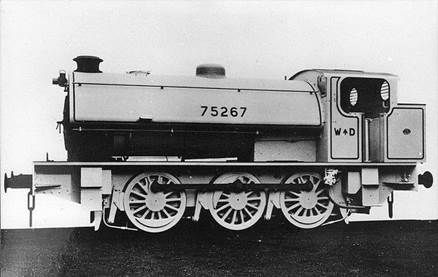
Figure 3. The
Austerity 0-6-0 Switch Engine.[8]
(Image
courtesy of Wikipedia)
On 25 December 1917, in time for Christmas, Springham was granted 14 days leave in the U.K. He returned to his company from leave on 9 January 1918 and resumed his Shunter duties. On 4 March 1918 he was injured in a shunting accident while temporarily performing the duties as an Assistant Guard on the 20.23 train from Poperinghe. Statements were taken from three witnesses to determine if the injury occurred while he was on duty. The men who submitted statements were 1569 2nd Corporal N. Munday, 81163 Corporal A. Anderson, R.E. and 252336 Sapper R. Moorhead, R.E. The statements were submitted to the Officer Commanding, 30th Broad Gauge Operating Company who summarized the circumstances of the case as follows:
193937 Sapper Springham, WS.
Railway Operating Division,
Royal Engineers
On 4.3.18 Spr Springham was assist. Guard on 20.23 train ex Poperinghe. He was engaged in tightening up the couplings and in getting out from between two wagons caught his head against an iron step of the wagon in front of him. (Signed Statements of witnesses attached).
Springham’s O.C. prepared this statement on Army Form W.3428, Report of Accidental or Self-Inflicted Injuries. The report was completed on 8 March 1918 with the opinion that the injury was caused in the performance of duty and that Springham was not to blame. The report was submitted to the Administrative Commander of the Fourth Army Railhead who concurred with the finding on 10 March 1918. The casualty was reported as an accidental injury. Springham had already returned to duty on the day after he was injured, so it appears that all of the paperwork described above was rather needless. It is interesting to note that Springham’s Regimental Number, 193937, was used in this report, but his unit was designated as WS rather than R.E. Apparently his Regimental Number WR/258995 was not yet being used.
On 11 April 1918 Springham’s Section Leader recommend him for an increase in Engineer Pay based on the work that he had been doing in the company. He was also recommended to be remustered from the Trade of Shunter to Guard, with an increase in pay of 4 pence per day. His duties as a Guard were modelled somewhat after those of Guards on British Railways in the U.K. Their jobs focused more on safe operation of the trains, timekeeping, handling equipment, and other consignments. As well as passenger care, Guards were trained in "emergency protection" duties, should an emergency arise, along with other operational roles. This involved using emergency kits such as detonators, track circuit clips and flags to prevent other trains colliding with stopped or derailed trains. If in a crash the driver was incapacitated, the Guard was the only person left to protect the train. As indicated in the accident report above, Springham had been performing the duties of an assistant Guard at the time of his injury, so he already had some experience in this position. The Lieutenant who submitted this recommendation identified him as WR/258995 Sapper Springham WS, so by April of 1918 Springham’s regimental number had finally changed. Springham’s unit was in the Calais-Rivière-Neuve area when this recommendation was made.
Sapper Springham continued to serve as a Guard until the war’s end. On 6 May 1919 he volunteered to remain with the Armies of Occupation at Calais following the war while he was still serving in the 30th Broad Gauge Operating Company. On 12 May his request was approved. On 29 July 1919 he was granted 14 days leave in the U.K., returning to his company on 10 August.
On 16 December 1919 Springham was transferred to the 8th Railway Company, one of the regular Royal Engineers railway construction companies, which had a long history of service long before the Great War. The regular R.E. railway companies remained on the continent after the war ended, while the war-raised units such as the 30th Broad Gauge Operation Company were disbanded. He was granted another leave from 20 March to 3 April 1920 and on 5 June he returned to the U.K. to be discharged. He was discharged at Chatham and his Army Form Z. 11 listed the following:
· Unit: 8th Railway Company, R.E.
· Character: Very Good.
· Trades: “Superior” Guard and “Skilled” Shunter.
· No disability claimed.
· Place of rejoining in case of emergency: Longmoor.
· Home address: 24 Southsea Avenue, Watford, Hertfordshire.
6. MEDALS, AWARDS AND DECORATIONS
For his service during the Great War Sapper Springham was awarded the British War Medal and Victory Medal.
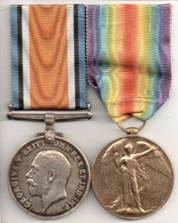
Figure 4. The British War Medal and Victory
Medal.
(Image from the author’s collection)
NOTE: The medals shown above are not Sapper Springham’s medals. They are shown here to illustrate the medals that he would have earned. The whereabouts of his actual medals are unknown.
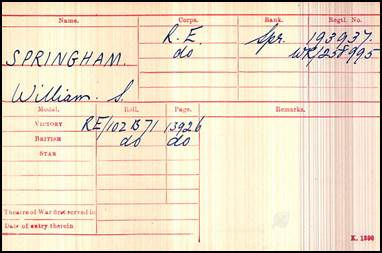
Figure 5. The Medal Index Card of Sapper
Springham.
(Image courtesy of Ancestry.com)
Marriage
William Stewart Springham married Charlotte Louisa Adams (1897-1987) in Watford, Hertfordshire in December 1928. Charlotte was a native of Norwood, London and the daughter of a cheese monger named William George Coombe Adams (1872-1963). Charlotte and her family lived in London until she was about five years old and then moved to Hertfordshire.
Children
William and Charlotte had one child; a son named Derek A. Stewart-Springham. Derek was born in Watford on 5 February 1930. He died in Salisbury, Wiltshire in December 1953.
Parents
William’s father died at the early age of 35 as previously indicated. His mother, Minnie Margaret Springham died on 26 August 1937 at the age of 65. Her address at the time of her death was The Old Cottage, Hunton Bridge, Kings Langley, Hertfordshire. The Probate of Minnie’s Will took place in London on 26 August 1937. Her effects in the amount of £773, 4 shillings and 4 pence (about $91,700 US in 2022 currency) were left to her eldest son, George Alan Springham, who is listed as a Fitter in the Probate Calendar.
Siblings
The birth information of all of William’s brothers was given in Section 2 of this narrative.
George Allen Springham
In 1911, at the age of 19, George Allen Springham was serving in a Territorial Force unit, the 2nd Battalion of the Duke of Wellington’s Regiment, at Candahar Barracks in South Tidworth, Hampshire. When the Great War began, George enlisted as a Private in the London Regiment, Regimental Number 2567 to serve in the war. He subsequently was transferred to the Royal Flying Corps, Regimental Number 401274, and on 9 March 1915 he was deployed to France. He received the 1914-15 Star, British War Medal, and Victory Medal for his service. His 1914-15 Star was awarded on the medal roll of the Royal Flying Corps (RFC/11C, page 790), which indicates that he may have transferred to the RFC prior to going to France or during late 1914 or in 1915. George was a Fitter in later life, so it may be safe to assume that he was a mechanic in the RFC during the war.
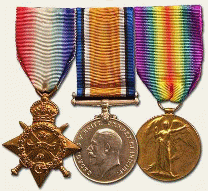
Figure 6. The 1914-15 Star, British War Medal
and Victory Medal.
(Image from the author’s collection)
NOTE: The medals shown above are not Springham’s medals. They are shown here to illustrate the medals that he would have earned. The whereabouts of his actual medals are unknown.
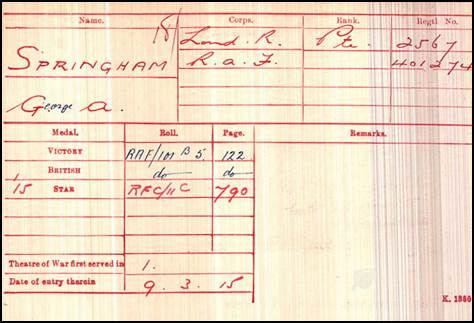
Figure 7. The Medal Index Card of Private George
A. Springham.
(Image courtesy of Ancestry.com)
George died in Bournemouth on 4 October 1959. His residence at the time was 28 Heather Road, Ensbury Park, Bournemouth. Probate of his will took place in Winchester on 23 December 1959 with his effects going to Annie May Springham, his widow. His effects amounted to £134, 18 shillings and 1 pence (about $4,600 US in 2022 currency).[9]
Alexander Stewart Springham
Alexander enlisted in the Royal Field Artillery on 16 August 1914. 64421 Bombardier Springham was posted to the 46th Battery, 39th Brigade and went to France with the initial British Expeditionary Force (the “Old Contemptibles”). The 39th Brigade was originally formed with 46th, 51st and 54th Batteries, and was attached to the 1st Division at Aldershot. In August 1914 it mobilized and was sent to France.
Springham’s battery took part in the following actions with the 1st Division up until the time of his death:
Battle of Mons, 23-24 Aug 1914.
Battle of the
Marne, 7-10 Sep 1914, including the passage of the Petit Morin and
the passage of the Marne.
Battle of the
Aisne, 12-15 Sep 1914, including the capture of the Aisne Heights and
the Chemin des Dames.
Battle of Langemarck, 21-24 Oct
1914.
Battle of Gheluvelt, 29-31 Oct
1914.
Battle of Nunne Bosschen, 11 Nov
1914.
Defence of Givenchy, 20-21 Dec
1914.
Battle of Givenchy, 25 Jan 1915.
Battle of Aubers, 9 May 1915, including the attack on Fromelles and the attack at Rue du Bois.
Battle of Loos, 25 Sep-8 Oct 1915.
Actions at the Hohenzollern
Redoubt, 13-19 Oct 1915.
Battle of Albert, 1-13 Jul 1916, including the capture of Montauban, Mametz, Fricourt, Contalmaison and La Boisselle.
Battle of Bazentin,
14-17 Jul 1916, including the capture of Longueval, Trones Wood and
Ovillers.
Bombardier Alexander Springham was killed in action on 17 July 1916 during the last day of the Battle of Bazentin, probably by German counter-battery fire during the battle. His death is commemorated on the Thiepval Memorial, Pier and Face 1A and 8A. His name also appears in the Watford Borough Roll of Honour and in the St. Michael and All Angels Church in Watford. For his service he was awarded the 1914 Star and bar, the British War Medal and the Victory Medal.
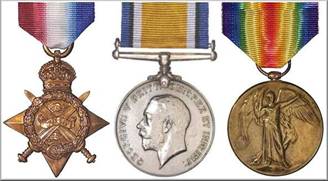
Figure 8. The 1914 Star, British War Medal and
Victory Medal.
(Image from the author’s collection)
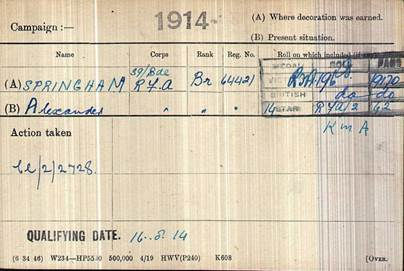
Figure 9. The Medal Index Card of Alexander
Springham.
(Image courtesy of Ancestry.com)
NOTE: The medals shown above are not Bombardier Springham’s medals. They are shown here to illustrate the medals that he would have earned. The whereabouts of his actual medals are unknown.
Henry Stewart Springham
J/40303 Able Seaman Henry Stewart Springer served in the Royal Navy aboard H.M.S. Amazon during the Great War. H.M.S. Amazon was a Tribal-class destroyer built for the Royal Navy in the first decade of the 20th century. During the war he served in the North Sea and in the English Channel with the 6th Destroyer Flotilla. Henry died on 11 August 1920 at the age of 20. He was buried in Watford Cemetery, Section F, Row 4, Grave 199. Since his death is commemorated by the Commonwealth War Graves Commission it is likely that his death was service related.
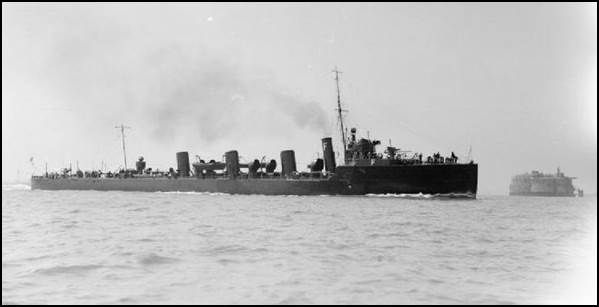
Figure 10. HMS Amazon, circa
1914.
(Image courtesy of Wikipedia)
James Stewart Springham
James enlisted in the Royal Navy on 10 February 1921 as a Boy (J93635). His service papers provide the following description of him at the time that he enlisted:
Apparent age: |
18 years |
Height: |
4 feet 11 inches |
Chest: |
32 inches |
Hair: |
Brown |
Eyes: |
Grey |
Complexion: |
Fresh |
James enlisted for 12 years and served for training on H.M.S. Impregnable. He was invalided out in 1925 due to appendicitis. HMS Impregnable was a training ship for Boys based at Devonport, Plymouth. She was an old 121 gun ship of 1860. initial named H.M.S. Howe and then renamed H.M.S. Bulwark, until 1886 when she was named H.M.S. Impregnable.
James died on 16 September 1971 at 11 Gallows Hill, Hunton Bridge, Kings Langley, Hertfordshire. Probate of his will took place at Ipswich, Suffolk with the recipient of his effects of £7,587 (about $159,800 US in 2022 currency) not specified. In the Probate Calendar his name is given as “SPRINGHAM, James Stewart or STEWART-SPRINGHAM.”
POST SERVICE LIFE
Little is known about William Stewart Springham’s life following the war except that he was residing at 16 Harper Road in Salisbury, Wiltshire in 1939. He died on 24 March 1973 in Hampstead, Greater London at the age of 76. His residence at the time was 24 Southsea Avenue in Watford, the old family residence. Probate of his will took place in Oxford with his heir not specified. His effects amounted to £9,502 (about $171,250 US in 2022 currency). Presumably his effects were left to his widow, Charlotte Louisa Springham.
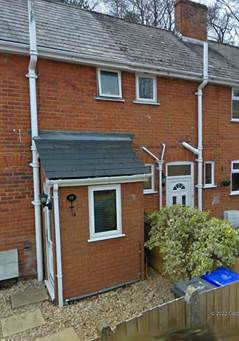
Figure
11. 16 Harper Road, Salisbury, Wiltshire.
(Image courtesy of
Google Earth)
Charlotte died on 20 December 1987 at The Old Manor Hospital on Wilton Road in Salisbury at the age of 90. In the 1988 Probate Calendar, page 7701, her name is shown as Charlotte Louisa Stewart Springham.[10] Probate of her will took place in Winchester on 25 February 1988 with her effects shown as “not exceeding £70000” and no heir specified. The “not exceeding £70000” appears to be an inheritance tax threshold.
REFERENCES:
Baptism Register
William Stewart Springham, 4 November 1896
Books
CORPS OF ROYAL ENGINEERS. History of the Corps of Royal Engineers, Volume V. The Home Front, France, Flanders and Italy in the First World War. The Institution of Royal Engineers, Chatham, Kent, 1952.
DAVIES, W.J.K. Light Railways of the First World War. Augustus M. Kelley, New York, 1968.
WILLIAMSON, H. The Great War Medal Collectors Companion, Volume II. Anne Williamson, Harwich, Essex, 2014.
Census
1901 Census of England (RG 13/1103)
1911 Census of England and Wales (RG 14/7714)
1939 Register of England
Family Trees (Ancestry.com by wen466068)
Alexander Stewart Springham (father)
Minnie Margaret Cox (mother)
William Stewart Springham (aka Stuart)
Charlotte Louisa Adams (wife)
Derek A. Stewart-Springham (son)
Internet Web Sites
Commonwealth War Graves Commission.
Military Documents
Medal Index Card (William S. Springham).
Medal Index Card (Alexander Springham).
Medal Index Card (Henry Springham).
Medal Index Card (George A. Springham).
Royal Engineers Medal Roll: British War Medal and Victory Medal.
U.K. Royal Hospital Chelsea Pensioner Soldiers Service Records, 1760-1920.
Great War Commemorative: Herts at War, 1914-1918.
Service Papers of William Stewart (aka Stuart) Springham.
a. Short Service Attestation (Army Form B. 2512).
b. Descriptive Report on Enlistment.
c. Statement of Services.
d. Medical History.
e. Discharge Certificate.
f. Identity Certificate of Recruit: Royal Engineers Railway and Canal Troops.
g. Accident Report dated 4 February 1918 describing injury to Springham.
h. Accident Report dated 5 March 1918 describing injury to Springham.
i. Accident Report dated 8 March 1918 describing injury to Springham.
j. Instructions Regarding Self-Inflicted Wounds.
k. Report on Accidental or Self-Inflicted Injuries.
l. Declaration for Volunteering for Retention in the Armies of Occupation.
m. Casualty Form – Active Service (Army Form B. 103).
n. Protection Certificate and Certificate of Identity (Army Form Z. 11).
o. Statement as to Disability (Army Form Z. 22).
p. Trade and Special Qualifications.
q. U.K., Royal Navy Registers of Seamen’s Services, 1848-1939 for James Stewart Springham.
Probate Calendars
1. 1959: George Alan Springham.
1971: James Stewart Springham.
1973: William Stewart Springham.
1988: Charlotte Louisa Stewart Springham.
ENDNOTES
[1] Springham family trees and Herts at War. In the 1959 Probate Calendar his middle name is spelled Alan rather than Allen.
[2] Springham family trees and baptism certificate.
[3] Hartney Wintney is just under 9 miles from Aldershot.
[4] Springham family trees.
[5] The residential structures currently at this address are too modern to have existed there in 1911 when the Springham family lived there.
[6] Herts at War.
[7] Based on the Snellen Visual Acuity Chart.
[8] Chosen by the War Department as its standard shunting locomotive.
[9] 1959 Probate Calendar.
[10] It seems that the name Stewart was interjected everywhere!